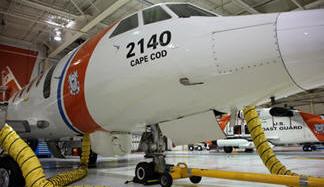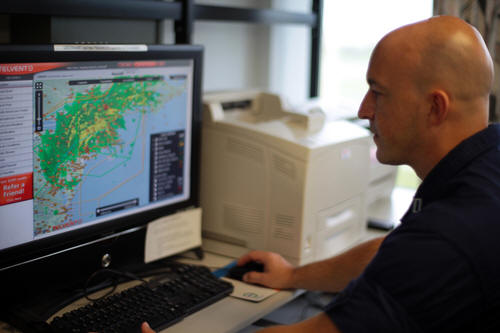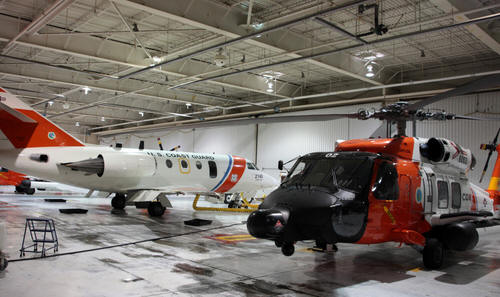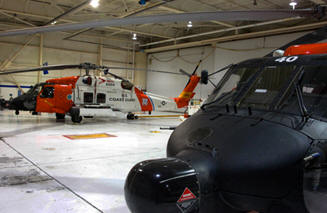|
|||||||||||||||||
|
|
|
|||
|
Hurricane Irene Put
Coast Guard Search And Rescue Air Crews To The Test By Eric J. Chandler |
||||
 |
October 14, 2011 - In 1786, a group of visionaries gathered at a Boston tavern with the shared goal of reducing the loss of life at sea. America's first maritime lifesaving service was born of their initiative, called the Humane Society of the Commonwealth of Massachusetts.
The practices of this agency were used in the creation
of the federalized U.S. Life Saving Service, which
merged with the Revenue Cutter Service to become the
Coast Guard in 1915. One of the first successful Coast Guard air stations was also established in Mass., utilizing a Vought UO-1 seaplane (borrowed from the Navy) at Ten Pound Island in 1925. |
|||
|
HU-25 Guardian (Falcon) Jet |
||||
|
The Coast Guard had successfully tested aircraft for search-and-rescue (SAR) purposes as far back as 1915, but hadn't yet been able to get the funding to put them to use. These days, Coast Guard aviators in the region fly out of Air Station Cape Cod.
I had the
privilege of deploying to this hot spot of lifesaving practice
and tradition on Aug. 27, 2011 to document the arrival of
Hurricane Irene. When word came that the storm would hit Mass.
on the 28th, the Coast Guard was ready with the wisdom of
centuries, satellite imagery and established agency
partnerships. Weathering storms in the Northeastern United
States is in our services ancestral DNA.
As Irene
struck the coast a single watch stander at Air Station Cape Cod.
Lt. Adam Burda, intently monitored phones and the VHF marine
band radio, a paradigm of the service's ageless devotion to the
call for help. Reports began to come in. Flash floods had driven
people onto rooftops in Connecticut. Power outages were
widespread throughout the Northeast.
"I have
stood my fare share of operations duty officer watch, and that
was the most hectic, but rewarding duty I've had yet," said
Burda. "Literally, the phone did not stop ringing for over 24
hours." Weekend watch standing duty at Cape Cod is 8 a.m. to 8
a.m., Sunday to Monday in this case, and Burda stood the entire
watch as normal. Men of the 'old guard' had a saying, "We have
to go out, but we don't have to come back." The romanticized
statement stood as a noble reminder of the potential martyrdom
of SAR jobs. These days we say, 'risk assessment.'
Risk
assessment is an outlined process that basically weighs the
peril of the person that needs saving versus the peril of the
crew going to save them. It helps determine what the best
vehicle, action or agency may be. National Guard troops, or
local responders could have more applicable capability to
perform a rescue. It isn't about being a hero as much as making
sure everyone gets to go home at the end of the day. |
||||
|
"One of my biggest concerns is putting my crew in harm's way, so we really urge folks to heed the warnings of their local authorities," said Lt. Cmdr. Curtis Brown, an aircraft commander and pilot at the air station. Brown spent a large part of the hurricane laying out charts and determining if our guys should launch. As the risk became acceptable, assets began to hit the tarmac and crews began to suit up.
The Falcon crew
screamed down the runway and hit the sky with wings dipping dramatically
as it was blasted by Irene's fury. The crew's manner was calm and
confident. Not a visible hint of fear. As the aircraft took flight the
wind gusted at 62 knots, or just slightly over 70 miles per hour.
As the Falcon crew
prepared for the return trip radio traffic began to ramp up. Through the
increasing activity, another rescue call was heard. A vessel in distress
was calling for help, and this one was unmistakable.
Landing and taking
off during the gusting winds was another memorable evolution. A third
search was conducted for an inflatable boat reportedly drifting in
Norwalk River, but nothing was found. After the search we landed at
Boston Logan Airport to wait for winds to subside. The international
airport was practically empty of aircraft and personnel, another eerie
moment. The crew finally ended up spending the night in Boston to wait
out the storm, and I departed by rental car back towards Cape Cod.
A report came in
at approximately 3:30 a.m., Aug. 29th, that waves had swept a man and
woman from rocks at Narragansett Beach, R.I. Reports stated that the man
had made it back to shore, but the woman was still at sea. An MH60T
Jayhawk helicopter crew was sent to assist.
The Jayhawk crew
located the person in the water and lowered a rescue swimmer. When he
reached her, the swimmer was notified by the young lady in the cold,
pre-dawn, post hurricane, Atlantic Ocean, that she was in no need of
assistance.
Capt. David
Throop, Commander of Air Station Cape Cod expressed that following the
storm one of the biggest things would be assessment of the ports. Other
agencies would be depending on our 'eyes in the sky' to determine what
areas would need aid and how to prioritize those needs. "This activity
would be essential to things returning to normal," said Throop.
At about 5 a.m.
the sun began to rise. The first Jayhawk helicopter had returned from
its rescue mission, and a second was on the tarmac getting ready to fly.
Stars in the west submitted to the rising sun in the east with a
cloudless sky between. Birds and insects remained strangely silent. I
remember thinking how strongly the environment contrasted the roaring
winds of the day before.
The assessment
helicopter picked up Congressman Tim Bishop, Senator Kirsten Gillibrand
and Capt. Joseph M. Vojvodich, Commander of Sector Long Island Sound.
The crew, passengers and I flew along the Sector Long Island Sound area
of operations where neighborhoods had become inaccessible, flooded and
lost power.
"I noticed some
surge waters in some communities in the northern portions of the Great
South Bay and Moriches Bay, but you could already tell that the water
was receding, said Vojvodich. "I was concerned about any breaches along
the south shore of Long Island and excessive shoaling of the inlets, but
we weathered the storm pretty well."
Air Station Cape
Cod was commissioned on Aug. 29th, 1970, celebrating its 41st birthday
the afternoon following the storm. It is the Atlantic Coast's only Coast
Guard aviation facility north of Atlantic City, New Jersey, and its area
of responsibility spans Northern New Jersey to the Canadian Border.
In Mass., early
notifications had not been ignored. When the storm arrived, airports
were like ghost towns and many neighborhoods had been evacuated. In the
region that gave us SAR, Hurricane Irene was a case study of
preparedness. Another storm for the books, to test our skills, crisis
communications and the effectiveness of our programs.
To the Coast
Guardsmen on watch it was a day representative of the reasons we join
the service. As a new response crew replaces those that stood the
hurricane watch, the same ritual is being conducted at stations up and
down the coast. Tales of the previous day are passed to the new ready
crew, and those lessons become part of the Coast Guard's ongoing story.
The HU-25 Guardian
(Falcon) is a medium-range surveillance fixed-wing aircraft. It is a
military derivative of the Dassault Falcon 20 business jet, of which
more than 500 were built for worldwide use. The HU-25 performs search
and rescue, law enforcement such as migrant and drug interdiction,
marine environmental protection and military readiness.
The first of 41
HU-25s was delivered in February 1982 and deliveries were complete by
December 1983. The HU-25A and HU-25D are 56 feet three inches in length
(the HU-25C is 57ft 6 inches), with a wingspan of 53 feet six inches and
height of 17 feet seven inches.
The service
ceiling is 42,000 feet, though current avionics restrict operations to
28,000 feet and below. Maximum cruise speed at altitude is 420 knots
(about 470 miles per hour), with a maximum operating speed of .855 Mach.
Sea-level maximum airspeed is 350 knots (about 400 miles per hour).
Key features of
the Falcon include its dash speed and capable mission sensors. The three
models of the HU-25 (-A, -C, and ?D) are distinguished by their sensor
complement. The HU-25A has an APS-127 surface search radar. The HU-25C
has an APG-66 air-to-air/surface search radar, electro-optical/infrared
(EO/IR) sensor, and tactical workstation. The HU-25D has an APS-143B
multi-mode radar, EO/IR and tactical workstation.
A sensor upgrade
program in 2002-03 improved capabilities in HU-25Cs and reconfigured 6
HU-25As into HU-25Ds. An avionics upgrade in 2005-06 upgraded the
navigation system with modern equipment common to the HH-65B.
A fully integrated
electro-optical/ infrared sensor system (ESS) with Trakkabeam
searchlight is permanently mounted outside the pilot?s door. ESS
provides aircrews with enhanced capabilities to locate, identify and
track surface targets day or night, which is a critical capability for
both search and rescue and law enforcement missions. Other capabilities
include the Helicopter Integrated Data Storage (HIDS), which stores
information from the ESS system, and the Helicopter Airborne Video
System (HAVS), which records audio and video from the ESS and the hoist
mounted camera that covers the hoisting area.
The history of Air
Station Cape Cod: - (From the Coast Guard Historian Office)
In Dec. of 1976,
the Liberian freighter Argo Merchant broke up after running aground on
Nantucket Shoals. The disaster brought marine environment protection to
the attention of the nation. The cargo carrier Eldia went aground on one
of the Cape?s outer beaches in early spring of 1984. An Air Station Cape
Cod HH-3F helicopter crew safely evacuated the fifteen-man crew of the
Eldia in winds in excess of 40 knots when the ship was in danger of
breaking up.
Probably the air
station?s most famous rescue occurred in 1987. In March of that year,
the Soviet Motor Vessel Komsomolets Kirgizzii sank 200 nautical miles
south of the Massachusetts coast. Three of Air Station Cape Cod?s
helicopters rescued the 37-man crew from the Russian ship in 20 foot
seas an winds gusting to 50 knots with no major injuries. For their
extraordinary efforts, the air crews were invited to the White House by
President Ronald Reagan to be honored in a Rose Garden ceremony.
On Dec. 28, 1988.
The 256-foot container vessel Lloyd Bermuda capsized in 35-foot seas
throwing its crew into the icy waters. An HU-25A Falcon jet and two
HH-3F helicopters set out in 50 knot winds and poor visibility to locate
the survivors. Working with limited fuel in the worst of conditions, the
crews successfully rescued six men, four of which survived. When it was
all over with, the crew of one helicopter had logged 9.7 hours in the
demanding flight conditions. |
|||||||||||
|
|
|||||||||||
 |
|||||||||||
| ?AvStop
Online Magazine
Contact
Us
Return To News
|
|||||||||||
|
|||||||||||





